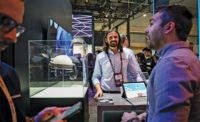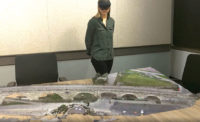Mixed reality holograms are the buzz this month as Microsoft released HoloLens devices. Different than previous, completely virtual experiences, HoloLens combines holographic technology with actual reality to create an environment where at-scale holograms can be projected into physical environments. For those of us who live in actual space—and not just in the video game realm—this has huge impacts on our ability to design, construct, operate and improve projects.
CDM Smith started actively evaluating and applying virtual and mixed reality since early 2015. Our Innovation Group and R&D program constantly evaluate new technologies, and there is no shortage of options these days. But, even within the flood of cool and different things, mixed reality stands out as something that could radically improve how we collaborate and deliver engineering and construction projects. In addition to our own engineering, construction and business technology professionals, we have partnered with the HoloLens startup Object Theory to accelerate our progress. Over the past seven months we have been defining AEC use cases and testing actual models in the HoloLens environment with a focus on collaboration to deliver infrastructure projects more efficiently. We have also been investigating opportunities to leverage mixed reality for facility operations, to reduce the lifecycle cost of projects for our clients. Here’s what we’ve learned:
· Combining the digital and physical world is powerful. In our industry, projects often happen within existing, operating facilities. We are designing and building plant upgrades or expansion projects that need to fit within an already defined physical space. With mixed reality, we were able to visualize how our projects would fit into an existing physical space and the implications new pipes or pumps would have on the space. Our designers were impressed with the tool and immediately saw applications for use, especially around piping and major equipment placement. Our operators were thrilled with the idea of being able to test out accessibility points and safety implications in a design state before large investments were made.
· It’s more than just the model. We’ve developed a method for bringing our 3D designs into the physical realm using HoloLens as a portal. Seeing a design tower over you at full scale will make your jaw drop, but the real value of the technology is in the collaboration it enables. Being able to visualize and review options with the team, no matter where they are, significantly reduces the time and effort to identify and resolve conflicts. For example, in resolving RFIs in a dynamic alternative delivery environment, efficient resolution of issues saves the project valuable time. Collaboration through mixed reality can enable our teams to engage all the stakeholders quickly, give them visual access to the site, and understand the implications of different design decisions within the physical context of the project.
· Avoiding ‘cyber-sickness’ is important. Many folks experience a seasick side effect from virtual reality. This is caused by the lack of connection to real space. Mixed reality, where the holograms are being projected into the actual, physical environment, enables peripheral vision and seems to eliminate the nauseous side-effect many felt when using pure virtual reality.
· Digital capital is the future. While we live in the built environment, how we manage our digital assets is becoming more and more important. These digital assets go beyond the model and now include data from new sensors attached to drones, embedded in infrastructure and myriad connected devices. Virtual design and construction (VDC) is about being able to collect, manage and analyze digital assets to empower companies to work quicker and with more precision. Mixed reality adds another dimension to the value proposition for VDC. While holograms may seem futuristic and right out of a science fiction movie, they are here today and can be applied to improve the design and construction experience on large, complex projects with multiple stakeholders.
· Facility Owner’s See the Value, too. We had the opportunity to showcase the Hololens devices and the holographic facility models we’ve created at the 2016 Design Build Institute of America conference in April. The owners who go to experience the holograms at scale were impressed! They immediately saw value in the ability to bring operators into the design process. One owner of a large water utility in California summarized the sentiment: “My operators are great idea guys, but if you give them a set of plans they won’t have too much to say. With this, they can really get involved and help the design.”
At CDM Smith, we recognize the power of mixed reality to improve how we deliver projects. In fact, we see mixed reality as a catalyst that will transform the AEC industry. We also know that it’s not something that you can pluck off the shelf and plug into every project. We’re investing in models and testing, and constantly collecting client feedback, to make sure we deploy this tool on the right projects. In addition, by leveraging our internal Enterprise Programs Office we are also ensuring we have the business processes and roles necessary to make this part of our project delivery workflow. We’re confident when used correctly, there are huge, positive implications for our industry. And we encourage others in the AEC industry to look into this technology also, to push the ball forward. We’re excited to see how it might change industry standards in the future.
David Neitz joined CDM Smith as the CIO in 2014. He has more than 20 years of experience in IT for professional services firms. Dave was chosen as one of Computerworld Magazine’s 2011 Premier 100 IT Leaders and he won CIO Magazine’s “Ones to Watch” Award and Standout Award for Change Leadership.
Marianne MacDonald is the Director of Enterprise Programs and R&D. She began with CDM Smith in 1998 supporting clients in strategic technology planning and implementation.



Post a comment to this article
Report Abusive Comment